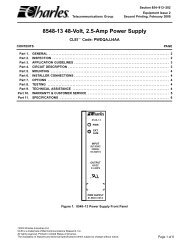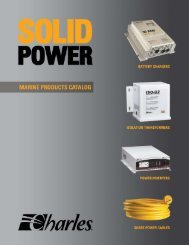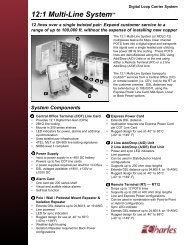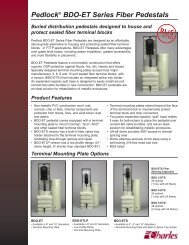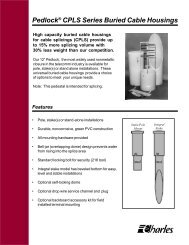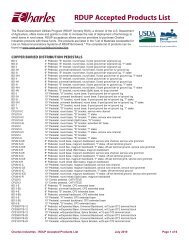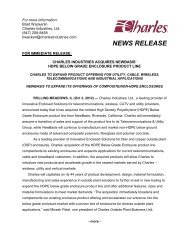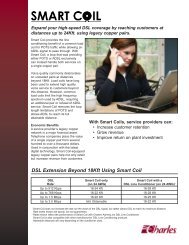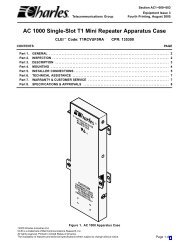Point-to-Point Delivery of T1 Circuits Using MM840L - Charles ...
Point-to-Point Delivery of T1 Circuits Using MM840L - Charles ...
Point-to-Point Delivery of T1 Circuits Using MM840L - Charles ...
Create successful ePaper yourself
Turn your PDF publications into a flip-book with our unique Google optimized e-Paper software.
Application Note – <strong>Point</strong>-<strong>to</strong>-<strong>Point</strong> <strong>Delivery</strong> <strong>of</strong> <strong>T1</strong> <strong>Circuits</strong><br />
<strong>Using</strong> <strong>MM840L</strong><br />
Application<br />
This application note describes a point-<strong>to</strong>-point application for the Mini-Mux 840L. The<br />
Mini-Mux 840L (“L” stands for “Lite”, hereafter referred <strong>to</strong> as <strong>MM840L</strong>) multiplexes 28<br />
<strong>T1</strong> circuits in<strong>to</strong> an OC-3.<br />
Description<br />
The goal in this application is <strong>to</strong> deliver up <strong>to</strong> 28 <strong>T1</strong> circuits from the Central Office <strong>to</strong> a<br />
Remote Location. Obviously the 28 <strong>T1</strong> circuits can be connected between the two<br />
locations with copper pairs. However, 28 <strong>T1</strong> circuits would require 56 copper pairs, in<br />
addition <strong>to</strong> <strong>of</strong>fice repeaters, and possibly field repeaters, depending on the length <strong>of</strong> the<br />
circuits.<br />
His<strong>to</strong>rically this application has been handled using Lucent DDM 1000/2000 equipment,<br />
as shown in Figure 1. However, there are disadvantages <strong>to</strong> this arrangement that the<br />
<strong>MM840L</strong> overcomes, namely space, power consumption, and cost.<br />
Fort Bragg: <strong>Point</strong>-<strong>to</strong>-<strong>Point</strong> <strong>T1</strong> <strong>Delivery</strong><br />
Lucent DDM 1000/2000<br />
Central Office<br />
Remote Location<br />
Voice<br />
Switch<br />
<strong>T1</strong>s<br />
DDM<br />
1000/2000<br />
OC-3<br />
1+1 APS<br />
DDM<br />
1000/2000<br />
<strong>T1</strong>s<br />
DMX<br />
DDM 1000/2000<br />
Over 6 RU (10.5”) <strong>of</strong> vertical rack space<br />
Large power consumption<br />
Costly<br />
Limited remote management options<br />
Figure 1 – DDM 1000/2000 for delivery <strong>of</strong> <strong>T1</strong> circuits<br />
Page 1 <strong>of</strong> 3 10/4/2005
Figure 2 shows this application using the Mini-Mux 840 Lite instead. One <strong>of</strong> the biggest<br />
advantages is the space and power savings. The <strong>MM840L</strong> is only 1 RU (1.75”) in height<br />
and draws a maximum <strong>of</strong> 35 Watts <strong>of</strong> power.<br />
Another key advantage is the integrated test features. The MM840 can do a number <strong>of</strong><br />
different loopbacks and diagnostics functions for troubleshooting <strong>T1</strong> circuits and/or the<br />
OC-3 link, such as<br />
• local (near-end) <strong>T1</strong> loopbacks<br />
• <strong>T1</strong> NIU/CSU loopbacks, with user configurable loop-up/down bit patterns<br />
• C-bit loopbacks, <strong>to</strong> loopback a single <strong>T1</strong> within the OC-3 payload<br />
• OC-3 loopback, for looping the entire OC-3 payload<br />
• <strong>T1</strong> test pattern genera<strong>to</strong>r and receiver for doing BERT tests without the need for<br />
external test equipment<br />
In this application, each <strong>MM840L</strong> was configured for T3 C-bit multiplexing. That is, the<br />
MM840 multiplexed the <strong>T1</strong> circuits as <strong>T1</strong>T3STS-1OC-3. Referring <strong>to</strong> Figure 2<br />
then, the Local Unit (located in the Central Office) can send a C-bit loopback request <strong>to</strong><br />
the Remote Unit for a particular <strong>T1</strong> circuit within the OC-3. Upon receiving the loopback<br />
request, the Remote Unit would loop only the traffic for that <strong>T1</strong> back on<strong>to</strong> the OC-3<br />
<strong>to</strong>ward the Local Unit. The Local Unit can then send and receive test patterns for that<br />
<strong>T1</strong>. The Local Unit would send the pattern on<strong>to</strong> the OC-3, the Remote Unit would loop<br />
the traffic back <strong>to</strong>ward the Local Unit, and the Local Unit would moni<strong>to</strong>r the traffic for<br />
errors. To verify the circuit, a technician can have the Local Unit inject errors in<strong>to</strong> the<br />
test pattern and verify the errors are received. And, with remote management, this<br />
entire test can be done from the Central Office location or a management station on the<br />
same network as the Local MM840 Unit.<br />
Page 2 <strong>of</strong> 3 10/4/2005
Fort Bragg: <strong>Point</strong>-<strong>to</strong>-<strong>Point</strong> <strong>T1</strong> <strong>Delivery</strong><br />
Mini-Mux 840 Lite<br />
Central Office<br />
Remote Location<br />
Voice<br />
Switch<br />
<strong>T1</strong>s<br />
<strong>MM840L</strong><br />
OC-3<br />
1+1 APS<br />
<strong>MM840L</strong><br />
<strong>T1</strong>s<br />
DMX<br />
Mini-Mux 840 Lite<br />
Only 1 RU (1.75”) <strong>of</strong> rack space<br />
Minimal power consumption (typically less than 30 Watts)<br />
SONET DCC allows management <strong>of</strong> both <strong>MM840L</strong> from the Central<br />
Office.<br />
Flexible remote management options, including a Web Browser interface<br />
Integrated testing features such as loopbacks and <strong>T1</strong> test pattern<br />
genera<strong>to</strong>r/receiver<br />
Figure 2 – Mini-Mux 840L for delivery <strong>of</strong> <strong>T1</strong> circuits<br />
Yet another key advantage is the remote management. The Local and Remote units<br />
communicate using a 192 kbps SONET DCC (Data Communications Channel). The<br />
<strong>MM840L</strong> has an integrated Web Browser interface. From any computer on the same<br />
network as the Local Unit, a technician can open a web browser (Internet Explorer,<br />
Netscape, etc.) and enter the IP address for either the Local Unit or the Remote Unit.<br />
An intuitive graphical web browser interface allows for moni<strong>to</strong>ring and management <strong>of</strong><br />
the <strong>MM840L</strong>. This allows technician(s) <strong>to</strong> moni<strong>to</strong>r for alarms, turn up circuits, and<br />
troubleshoot using the loopback and BERT functions on either or both <strong>MM840L</strong> units.<br />
Further Information:<br />
Further information on <strong>Charles</strong> Industries products may be found at:<br />
http://www.charlesindustries.com<br />
For further information on this application, please contact:<br />
Jeff Warren<br />
Systems Engineer<br />
<strong>Charles</strong> Industries<br />
847 258-8470<br />
mail<strong>to</strong>:jwarren@charlesindustries.com?subject=App note question<br />
Page 3 <strong>of</strong> 3 10/4/2005



